Is there anything more glorious than making bread from scratch? Honestly...not in our house!
Watching the dough rise during the proofing process. Smelling the bread as it cooks. Taking that first bite. It all adds to a truly unforgettable experience. This recipe takes a bit of a time commitment, but the results are truly phenomenal and we think worth every bit of time and effort. We're certain you'll feel the same way.
VIDEO ALERT: Be sure to check out the video for this recipe in the recipe card. If you like the video, subscribe to our YouTube Channel!
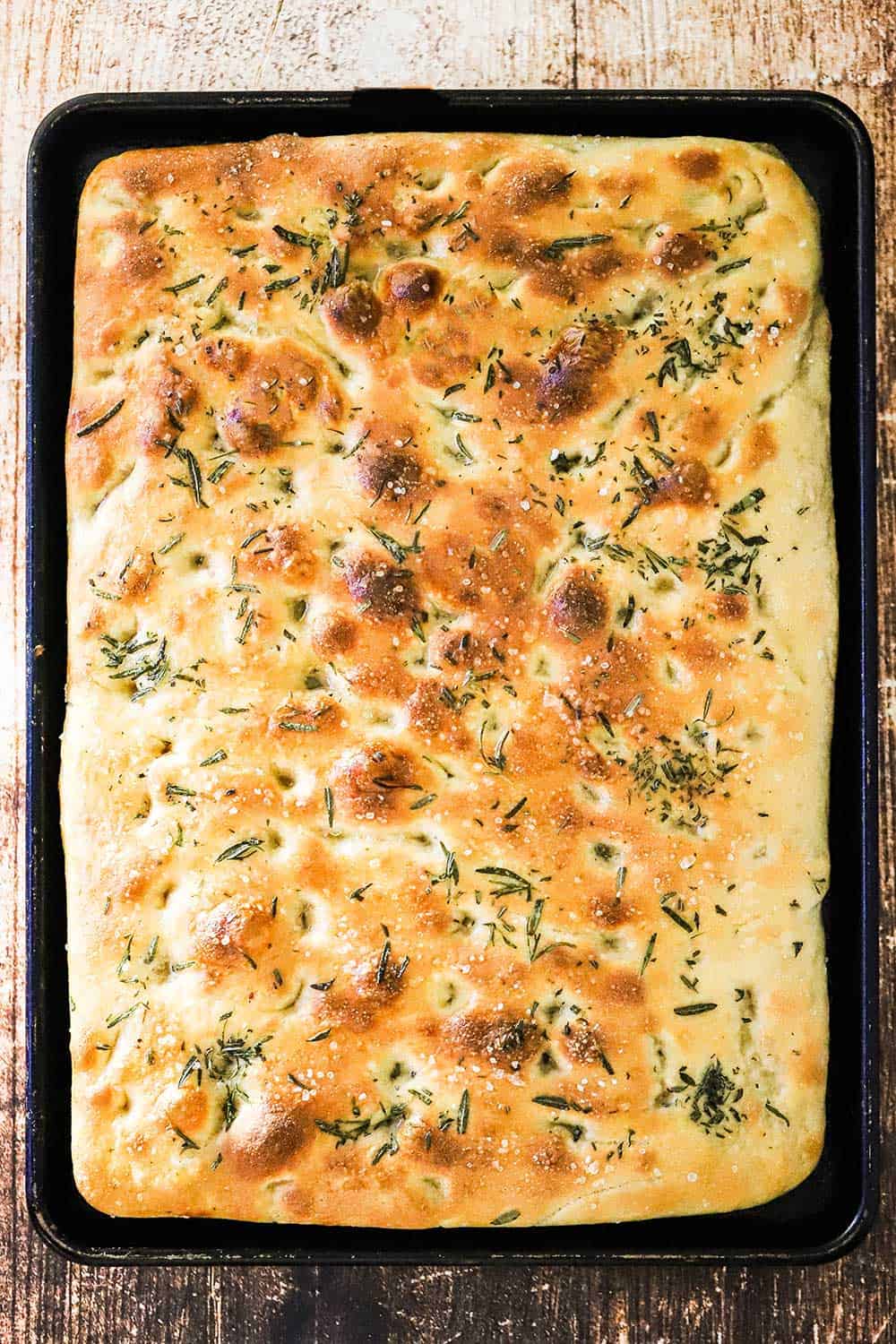
How To Make Foccacia From Scratch
There are definitely some tips and techniques to follow to get perfectly made focaccia bread every single time. But don't worry, we'll go over each one and give you the confidence to make this bread like a master baker in your own kitchen.
As mentioned, you'll need to carve out most of the day to make this bread, but most of the time requires no work at all. The perfect weekend project! Or, you break it up, and start in the evening, and finish up the following morning.
How Much Time You Need
You'll need to allow about 7 hours in total when making focaccia from scratch. Much of this time is reserved for allowing the dough to proof, or rise.
In the bowl of a stand mixer, add the bread flour. With the mixer on low, you'll add the room temperature water (70° to 73°F) and 1½ teaspoon of sugar.
EXPERT TIP: As the dough begins to come together, it won't be fully combined and will appear a little flakey, or shaggy. This is normal. Cover with a kitchen towel as you prepare the yeast mixture.
Making the Dough
Now, it's time to reactivate the yeast. Yeast is critical to making bread. It acts as a leavener, dough developer, and flavor builder. Learn more about its crucial role in breadmaking here.
In a small bowl, add ½ cup of warm water (95° to 105°F). Whisk in one package of active yeast and 1½ teaspoon of sugar.
EXPERT TIP: Make sure to check the date on your package of yeast. If the package is a year old or less, you should be fine. As the yeast becomes active, it will start to foam. If this doesn't happen at all, your yeast may be dead. You can also use Rapid Rise or Instant Yeast. Within 8 to 10 minutes, the yeast should be nice and foamy. If not, you'll need to get some new yeast.
Now, it's time to incorporate the yeast mixture into the dough.
Turn your mixer on low and add the yeast mixture in small amounts. You will notice that the dough will still have liquid visible that did not get absorbed into the dough. Stop the mixer and use your hands to massage the yeast liquid into the dough.
Now the dough is ready to proof for the first time. Transfer the dough to a large bowl that has been very liberally greased with olive oil. Turn the dough over to coat with oil. Cover with plastic wrap. Place the dough in a warm, non-drafty area for about 2½ hours, or until doubled in size.
NOTE: Focaccia dough remains quite sticky throughout the process. Don't let this throw you. Your hands will get a little of the dough stuck to them from time to time. That's okay. Have a little bowl of olive oil nearby. If you want, rub a little oil on your fingers, this will make working with the dough easier.
The Best Pan for Focaccia Bread
We love using our 18"x13" rimmed baking pan for this recipe.
After adding a couple more tablespoons of olive oil to the pan, fold the dough over in the bowl of few times to deflate it.
EXPERT TIP: Once you transfer the dough to the prepared baking pan, use oiled fingers/hands to stretch the dough to the edges. Most likely, the dough will want to retract and will spring back towards the center. No problem. Simply cover the pan with the dough with plastic wrap and let it rest for 10 minutes. Then, remove the wrap and try again. You should have better luck this time.
Now, it's time to chill the dough for a while. Cover with plastic and place the pan in the refrigerator for 2 hours.
When the 2 hours is up, remove from the fridge and place in the same warm, non-drafty area and allow to proof for another hour.
EXPERT TIP: Now, it's time to bake the bread! To get that classic focaccia look, use your oiled fingers to make deep dimples all over the dough. This also helps to release gas in the dough, which will help to create a spongy and airy interior.
Enhancing the Flavor of the Bread
The dough itself, along with good-quality olive oil, will produce an incredibly delicious baked bread.
However, we love adding a healthy amount of fresh rosemary that has been roughly chopped and a liberal sprinkling of coarse sea salt.
EXPERT TIP: It may feel like you are adding excessive amounts of olive oil during the making of this bread. Don't worry, the bread can take a lot of olive oil, and not only helps in enhancing the taste, but it also keeps the bread from sticking to the pan and helping the top to brown perfectly.
We love making all kinds of bread and baked goods, including:
But there is truly something extra special about this homemade focaccia bread! Heavenly!
How To Serve Focaccia Bread
Homemade focaccia bread is absolutely wonderful when served warm or at room temperature before the main meal.
You will find the folks love it so much, they'll enjoy the freshly made bread throughout the evening.
Just set out a platter of the sliced bread and watch how quickly it gets gobbled up.
You know have a wonderful weekend project to enjoy!
Carve out some time to make this incredible bread and you and your loved ones will be so happy that you did.
EXPERT TIP: The bread, of course, is extremely delicious by itself, but if serving as an appetizer, up the ante by creating a dipping oil, which is nothing more than good-quality olive oil (or extra-virgin olive oil) with a teaspoon of your favorite dried herbs added in, such as oregano, rosemary, basil, and marjoram. A few pinches of red pepper flakes are great, too. Allow the oil to sit with the herbs for a few hours before serving.

Focaccia with Rosemary and Olive Oil
Video
Equipment
- Stand mixer with dough attachment
- 18"x13" rimmed baking pan
Ingredients
- 6¼ cups bread flour 1 lb 9 oz
- 2½ cups water room temperature (70 - 74°F), 600 ml
- 3 teaspoon sugar divided
- ½ cup warm water 95 - 103°F, 120 ml
- 2¼ teaspoon active dry yeast 1 package, ¼ oz
- 1 tbsp + 1½ tsp Kosher salt
- ½ cup olive oil plus more, as needed
- 2 tablespoon rosemary fresh, roughly chopped
- 1 tablespoon sea salt coarse, plus more for garnishing
Instructions
- Attach the dough attachment to your stand mixer. In the bowl, beat together (on LOW) the flour, room-temperature water, and 1½ teaspoon sugar until a rough, shaggy dough forms, about 3 minutes. Remove the dough attachment, set it aside (you'll be using it again, soon), and cover the bowl with a kitchen towel and let stand while you prepare the yeast mixture.
- In a small bowl, add the warm water. Whisk in the yeast and the remaining 1½ teaspoon of sugar. Let stand until foamy, about 8 - 10 minutes.
- Take the towel from the mixer. Re-attach the dough attachment. With the mixer on LOW, add the yeast mixture a little at a time until it's all been added. Stop the mixer, remove the attachment (keep it handy, though), and massage the liquid from the yeast mixture into the dough. Don't worry if it doesn't get 100% incorporated. The dough will be very wet.
- Re-attach the dough attachment and sprinkle in the Kosher salt (1 tablespoon plus 1½ tsp). Turn the mixer on MEDIUM speed and beat until the dough is elastic, sticky, and pulls away from the sides of the bowl, about 5 minutes.
- Add 3 tablespoon of olive oil to a large bowl. Swish the oil around to coat the sides. Lightly oil your hands, and scrape the dough from the mixer bowl into the oiled bowl. Loosely cover with plastic wrap and place in a warm, non-drafty area until doubled in size, about 2½ hours.
- Add another couple of tablespoons of olive oil to an 18"x13" rimmed baking pan.
- Take the plastic off of the dough and gently use your hands to deflate the dough. Scrape the dough onto the oiled pan. Use your fingers to stretch the dough toward the edges of the pan. Most likely, the dough will want to pull back to the center. If so, cover with a couple of pieces of plastic wrap and allow the dough to rest for 10 minutes. Remove the plastic and try again. If the dough doesn't completely reach the corners, this is fine. Cover with plastic wrap and place the pan in the refrigerator for 2 hours, or overnight.
- Remove the pan from the refrigerator and place it back in the warm, non-drafty area for 1 hour.
- Preheat your oven to 450°F.
- Remove the plastic. Dip your fingers in a little bowl of olive oil, and then press your fingertips firmly into the dough to make deep dimples all over the dough.
- Sprinkle on the chopped rosemary and sea salt.
- Place in the oven. After 10 minutes, drizzle 2 more tablespoons of olive oil all over the surface, and then rotate the pan 180°. Bake for another 10 minutes, or until the top is golden brown.
- Place the pan on a baking rack and let cool for at least 10 minutes. Brush the surface of the focaccia with a little more olive oil. Cut into slices and serve warm or at room temperature.
Notes
Nutrition
POST UPDATE: This post was originally published in June 2014, but was updated with a recipe adapted from the amazing cookbook from Williams-Sonoma called Baking Favorites.

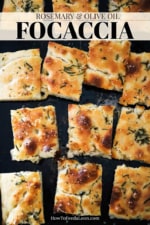
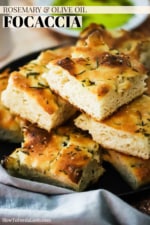

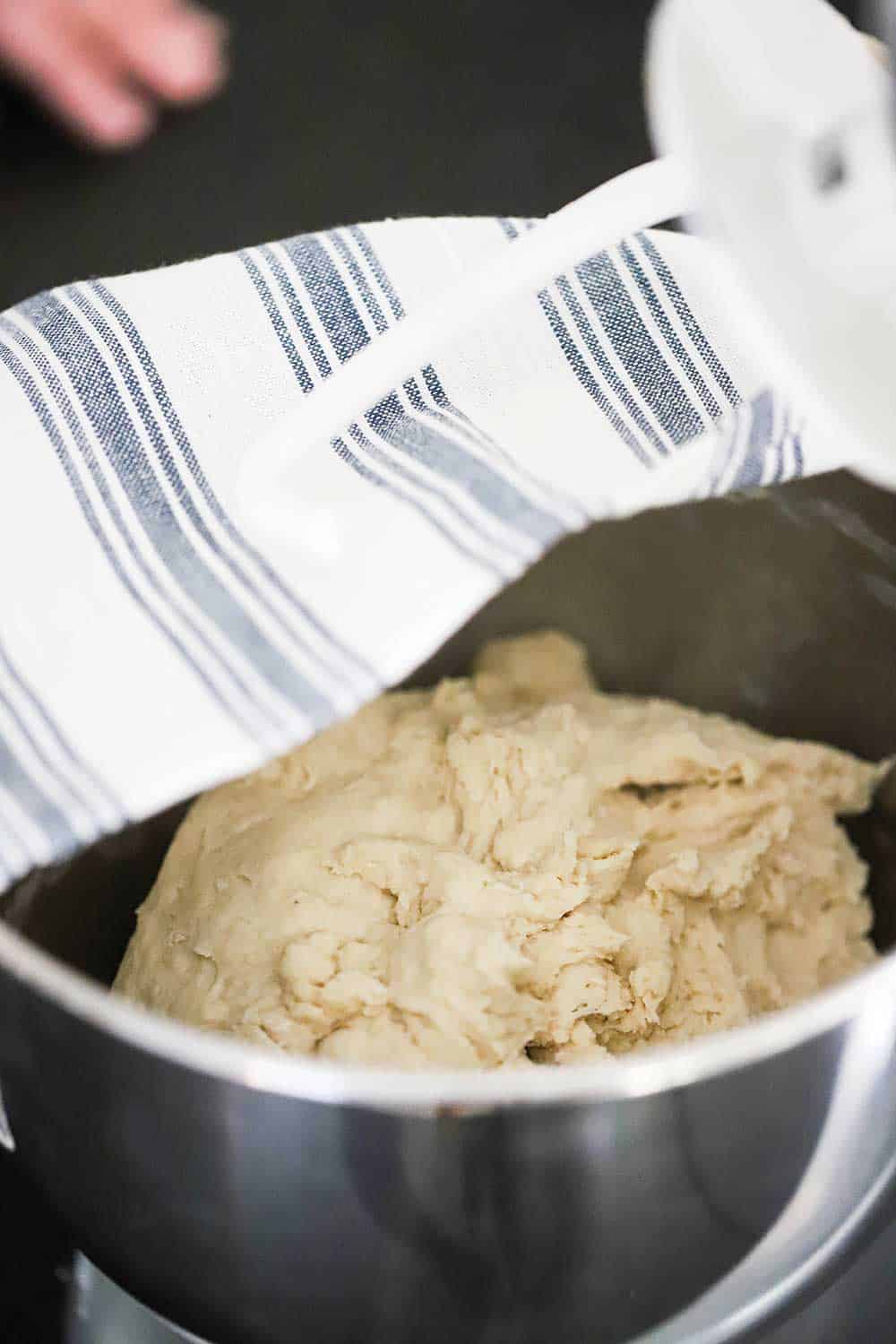

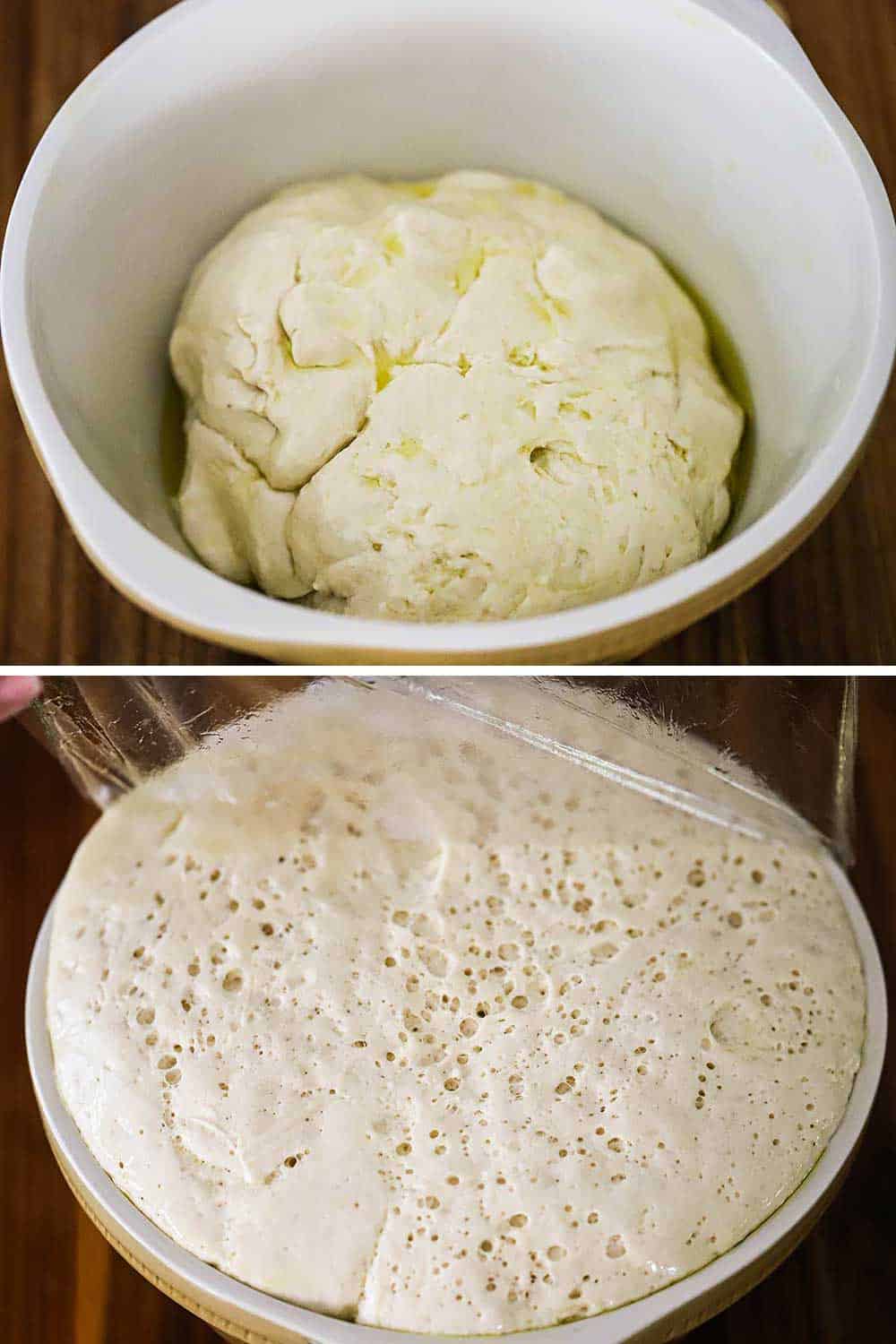
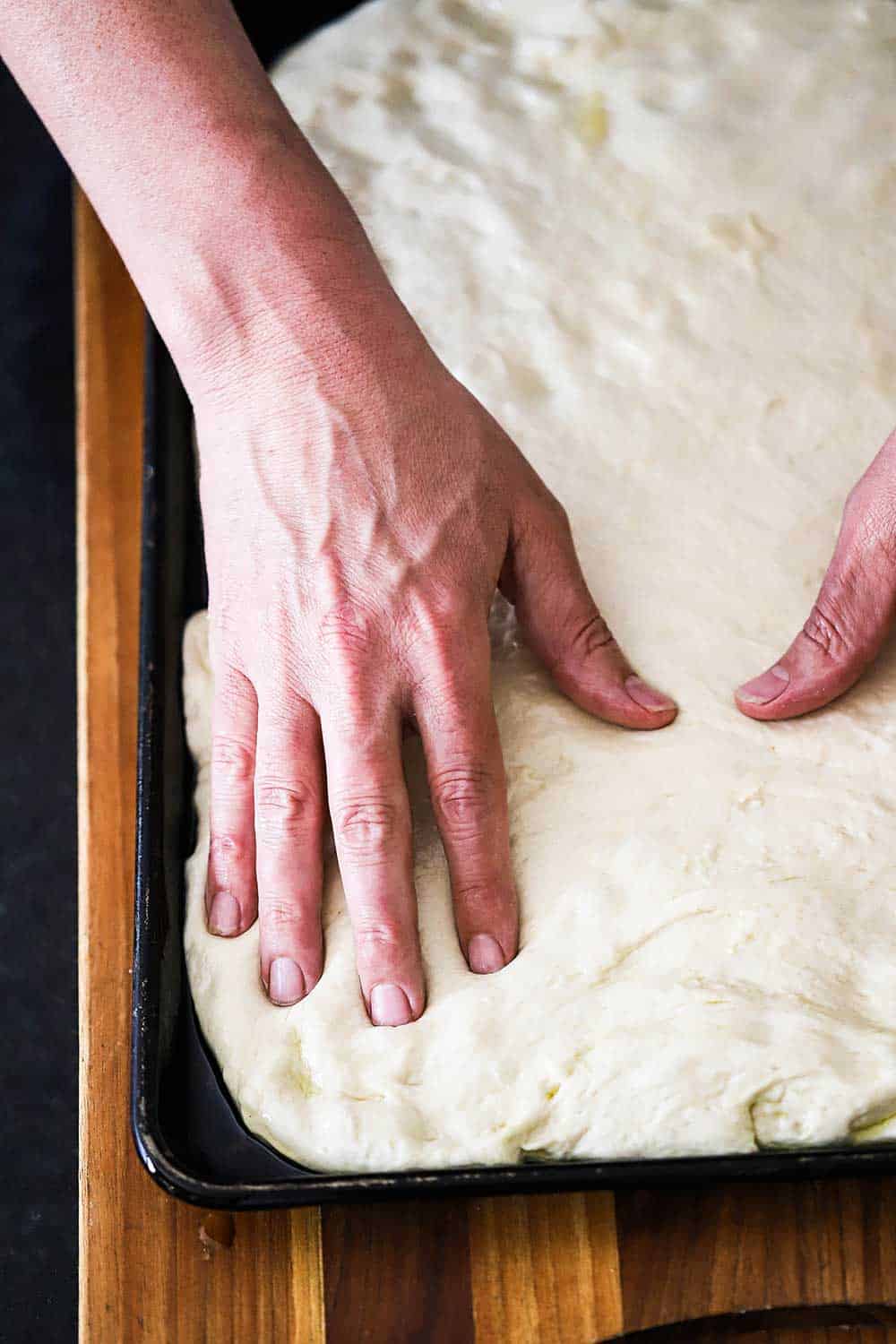
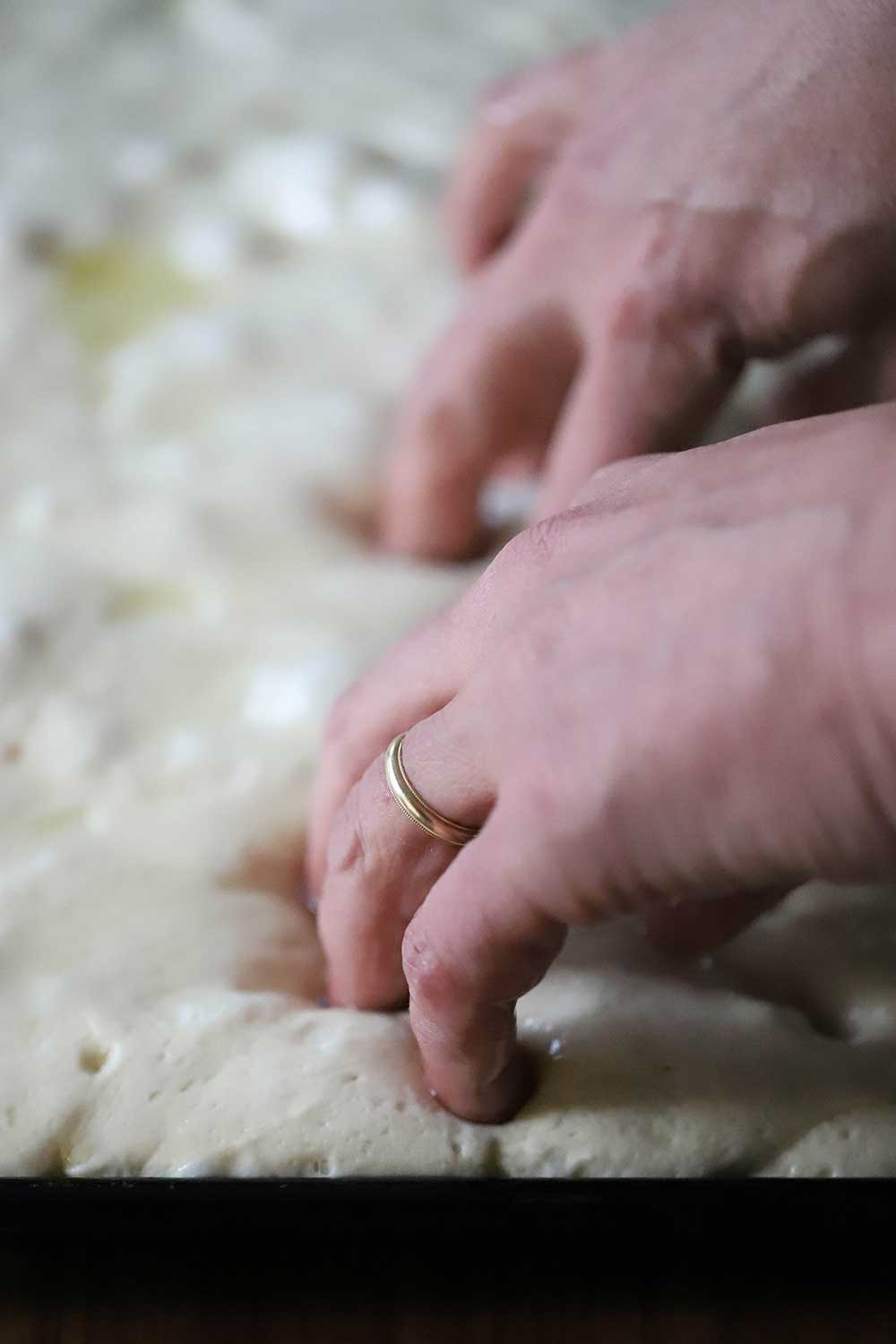
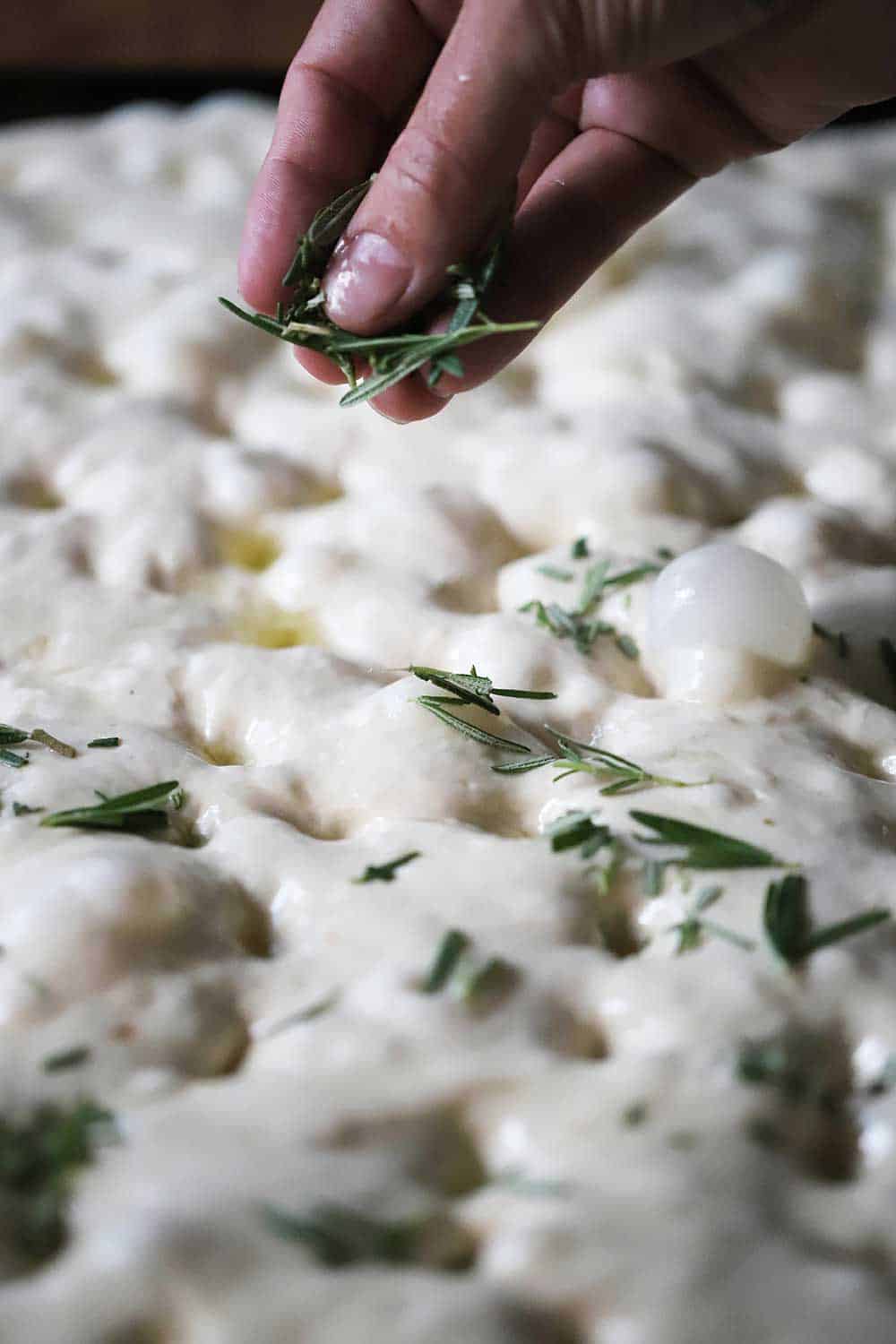
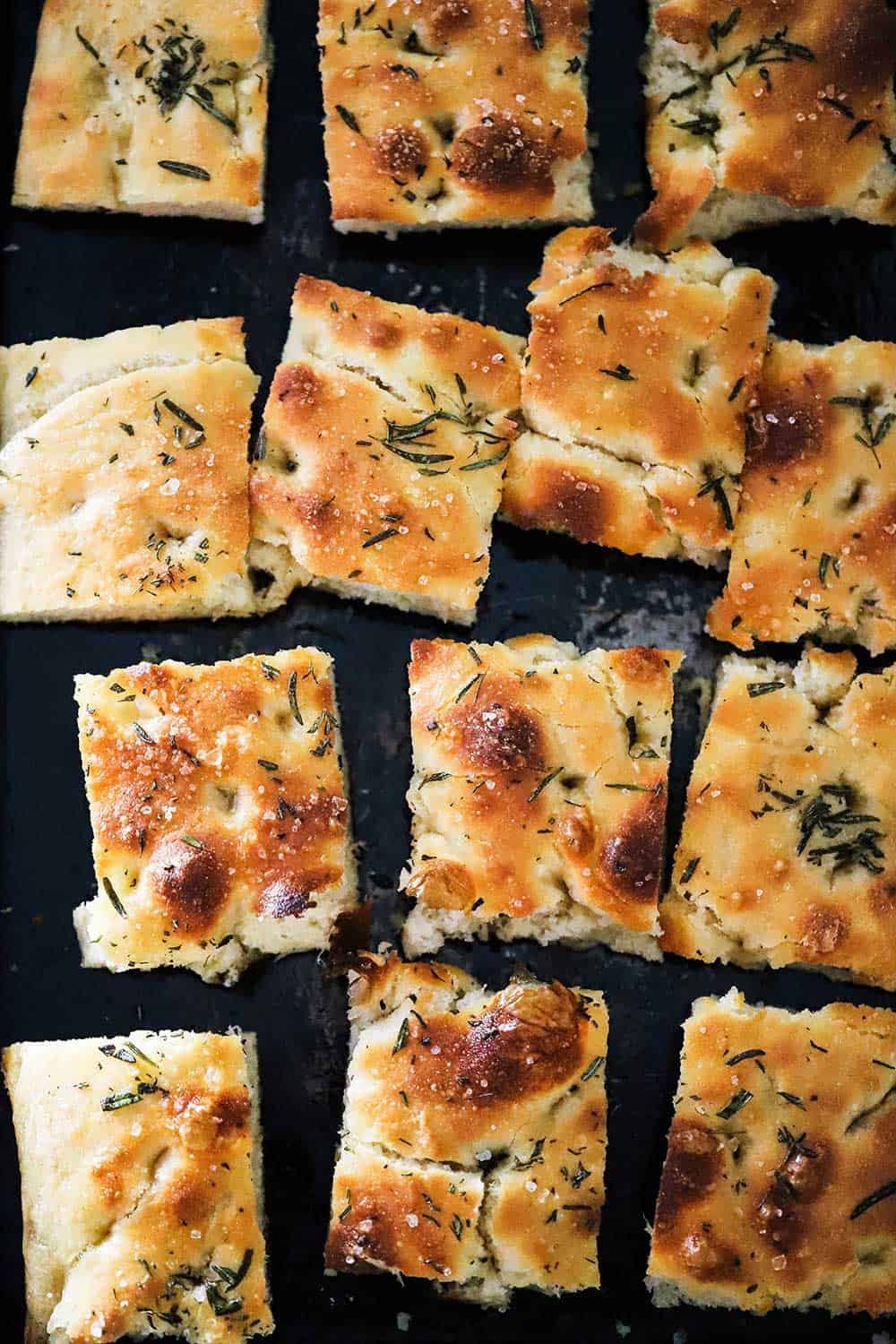
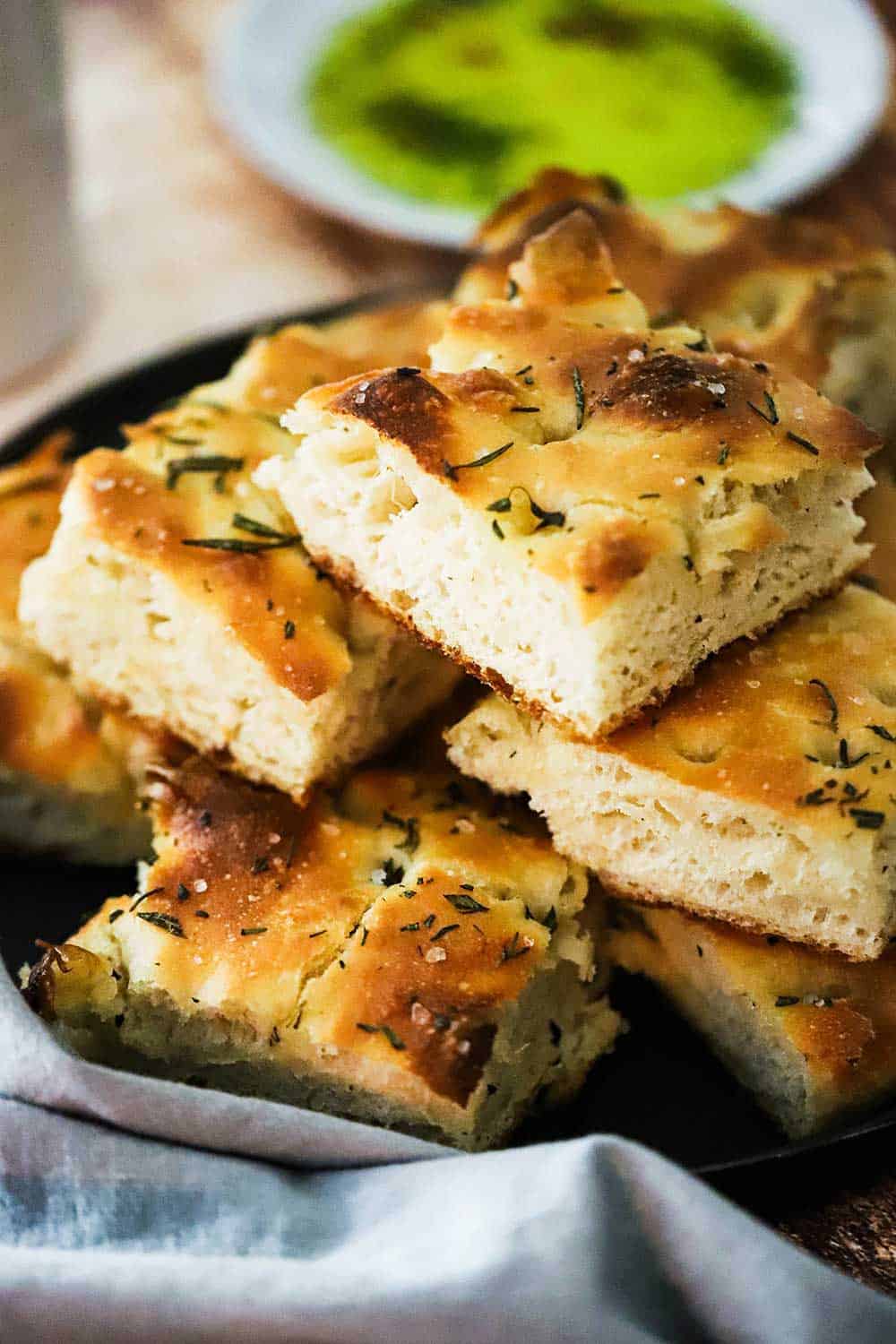
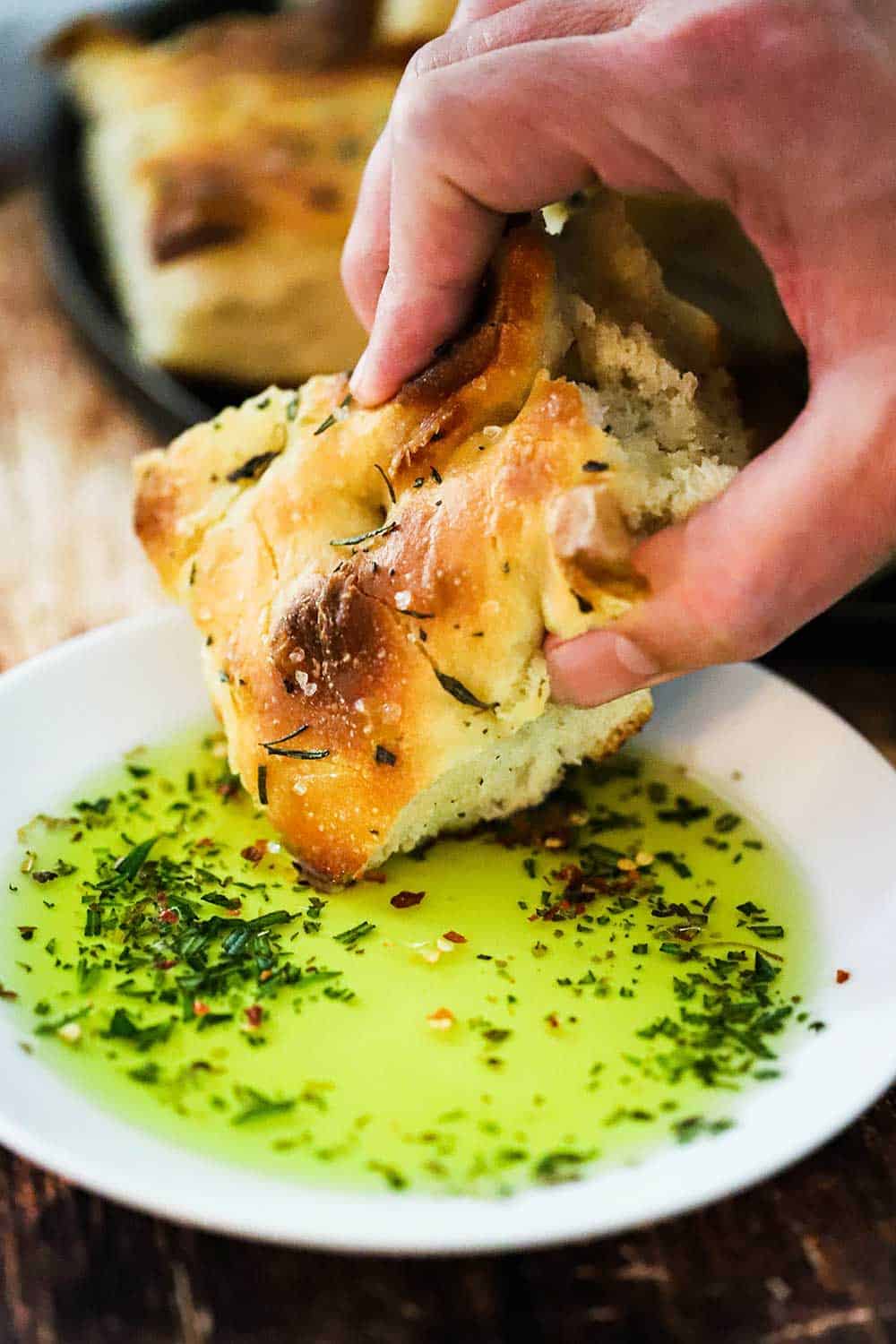

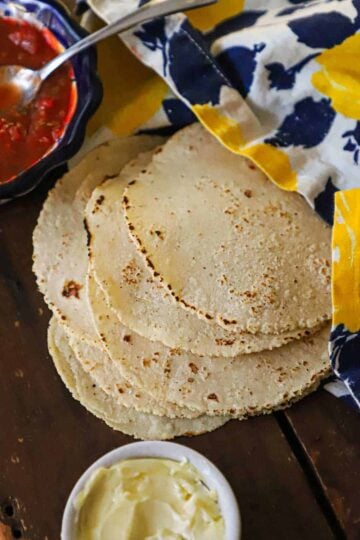
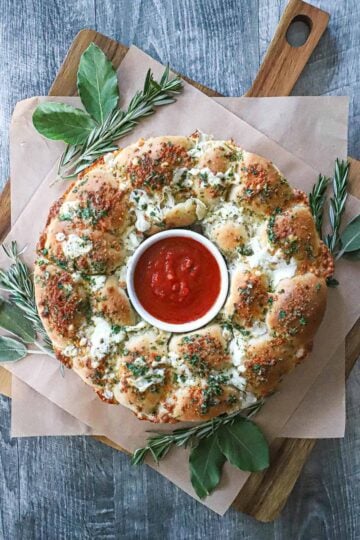

Dave Z says
I just love this recipe, takes a little time but well worth the wait. Definitely will be making this again.
Thanks
Kris Longwell says
Hi Dave! It is a bit of a labor of love, but we agree...the end result is just incredible! We are so glad you had success with the recipe and let us know. We appreciate that so so much!! All the best, Kris & Wesley
Kit says
Just made it...delicious! Long process but so worth the wait!
Kris Longwell says
Hi Kit! Homemade focaccia is definitely a labor of love, but we agree that it's so worth it! We are thrilled you had such great success with the recipe! And thank you so much for letting us know and for the wonderful review! That means the world to us!! All the best, Kris & Wesley
carol abrams says
Tried this today, a little worried about the consistency of the dough, but it turned out perfectly, now just have to share it with my neighbours as there is no way I can eat it all.
I know they will love it.
thanks again Guys for another great recipe
Kris Longwell says
Hi Carol!! So sorry for the delayed response but we are THRILLED the focaccia ending being a success for you!! The dough at the beginning does feel a bit strange...but it all works out in the end! Thank you for letting us know and for the wonderful review! That means the world to us!! All the best, Kris & Wesley
Amy says
Made it last night and it was indeed fantastic!
Marilyn says
Delicious!